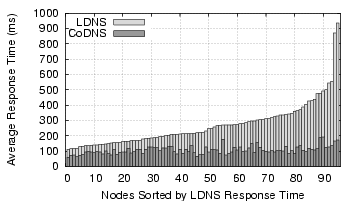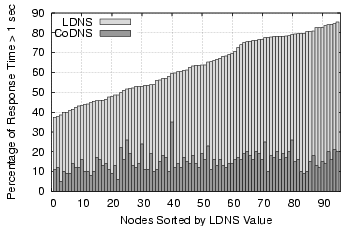



Next: Non-Internet2
Benefits
Up: CoDNS: Improving
DNS Performance
Previous: Bootstrapping
To gauge the effectiveness of CoDNS, we compare its behavior with
local DNS on CoDeeN's live traffic using a variety of metrics. CoDeeN
receives 5-7 million requests daily from a world-wide client
population of 7-12K users. These users have explicitly specified
CoDeeN proxies in their browser, so all of their Web traffic is
directed through CoDeeN. The CoDeeN proxies maintain their own DNS
caches, so only uncached DNS names cause lookups.
To eliminate the possible caching effect on a nameserver from other
users sharing the same server, we measure both times only in CoDNS,
using the slaves to indicate local DNS performance.
CoDNS effectively removes the spikes in the response time, and
provides more reliable and predictable service for name lookups.
Figure 13
compares per-minute average
response times of local DNS and CoDNS for CoDeeN's live traffic for
one day on one PlanetLab node. While local DNS shows response time
spikes of 7 seconds, CoDNS never exceeds 0.6 seconds. The benefit
stems from redirecting slow lookups to working peers.
The greater benefit of CoDNS lies in reducing the frequency of slow
responses. Figure 14
shows a CDF and a
weighted CDF for name lookup response distribution for the same node
for one week.
The CDF graph shows that the response distribution in both schemes is
almost similar until the 90th percentile, but CoDNS reduces the
lookups taking more than 1000ms from 5.5% to 0.6%.
This reduction gives much benefit in total lookup time in the weighted
CDF. It shows CoDNS now spends 18% of total time in lookups taking
more than 1000ms, while local DNS still spends 75% of the total time
on them.
This improvement is widespread - Figure 15(a)
shows the statistics of 95 CoDeeN nodes for the same period. The
average number of total lookups per node is 22,208, ranging from
12,119 to 131,466 per node. The average response time in CoDNS is
60-221ms, while that of local DNS is 113-935ms. In all cases, CoDNS's
response is faster, ranging from a factor of 1.37 to 5.42.
Figure 15(b) shows
the percentage of slow
responses in the total response time. CoDNS again reduces the slow
response's portion dramatically to less than 20% of the total lookup
time in most cases, delivering more predictable response time. In
contrast, local DNS spends 37% to 85% of the total time in the slow
queries.
Figure 15: Live
Traffic for One Week on the CoDeeN Nodes, LDNS =
local DNS

(a) Average Response Time
|

(b) Slow Response Time
portion
|
Subsections



Next: Non-Internet2
Benefits
Up: CoDNS: Improving
DNS Performance
Previous: Bootstrapping
KyoungSoo Park
2004-10-02


